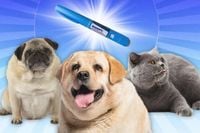San Diego-based Viking Therapeutics (NASDAQ: VKTX) sent shockwaves through the biotechnology sector on August 20, 2025, as its stock plummeted by over 30% in early trading. The dramatic sell-off followed the release of disappointing Phase 2 clinical trial results for its much-anticipated oral obesity drug, VK2735, raising major questions about the future of oral weight-loss therapies and the company’s place in a fiercely competitive market.
The setback came just a day after another biotech, Okava, announced a novel approach to tackling obesity—this time for pets—by developing an animal-friendly version of blockbuster weight-loss drugs like Ozempic and Wegovy. Okava’s plan to roll out its product by the decade’s end highlights the broadening scope and urgency of the global obesity crisis, both human and animal.
Viking’s oral VK2735 had been a bright spot for investors. The drug demonstrated impressive efficacy in the Phase 2 VENTURE-Oral Dosing trial, achieving up to 12.2% weight loss over 13 weeks. That’s no small feat, and it even edges out some competitors over the same period. But the devil, as always, is in the details. The trial’s Achilles’ heel was tolerability: 28% of patients on VK2735 discontinued treatment, compared to 18% in the placebo group. At the highest dose, a staggering 38% of participants dropped out, primarily due to gastrointestinal side effects. While 99% of those side effects were classified as mild or moderate, the sheer volume of dropouts spooked investors and analysts alike.
According to Market Minute, the immediate fallout was severe for Viking, which had previously enjoyed a surge in its stock price amid optimism about its obesity pipeline. The company’s management and research teams now face the daunting task of addressing these tolerability concerns, while investors are left to re-evaluate their bets in the rapidly evolving weight-loss drug market. Some analysts called the stock drop “extreme and unwarranted” given the drug’s efficacy, but others warned that the tolerability issues could seriously undermine its commercial prospects and competitiveness against established injectable therapies.
In contrast, the news proved a boon for established giants in the GLP-1 agonist arena. Shares of Novo Nordisk (NYSE: NVO) and Eli Lilly (NYSE: LLY) rose following Viking’s announcement, reflecting renewed investor confidence in their oral and injectable obesity drug pipelines. Novo Nordisk’s oral version of Wegovy (semaglutide) is awaiting FDA approval, and its oral amylin analog, amycretin, is also showing promise. Eli Lilly’s orforglipron—a competing oral GLP-1 receptor agonist—has demonstrated lower discontinuation rates and longer trial durations, while its injectable Zepbound (tirzepatide) already leads the market. As a result, both companies are poised to solidify their dominance and potentially expand their market share as rivals stumble.
The ripple effect extends beyond these titans. Roche, having acquired Carmot Therapeutics and its oral GLP-1 candidate CT-996, could benefit if its drug shows a better balance between efficacy and tolerability. Altimmune (NASDAQ: ALT), developing the dual receptor agonist pemvidutide, may also see renewed investor interest as the market scrutinizes tolerability profiles more closely. For smaller biotechs with early-stage oral GLP-1/GIP programs, however, Viking’s disappointment—and Pfizer’s earlier discontinuation of danuglipron due to liver injury and high dropout rates—casts a long shadow. Investors are likely to become more skeptical, raising the bar for funding and partnerships unless companies can demonstrate a clear edge in both efficacy and tolerability.
Viking’s own injectable VK2735 remains a glimmer of hope. Earlier Phase 2 data showed up to 14.7% weight loss after 13 weeks, and the injectable is now in Phase 3 trials (VANQUISH-1 and VANQUISH-2). Should these trials deliver positive results, the injectable could become a significant contender in the obesity market, with a possible launch around 2027. Its once-monthly dosing regimen could offer a distinct advantage over weekly injectables, potentially making it a “third major player” in the GLP-1 market, as some analysts suggest.
The oral VK2735, despite its recent setback, isn’t being abandoned just yet. Viking plans to advance the formulation to Phase 3, possibly with slower dose titration to improve tolerability. With an estimated launch window around 2028-2029, the company hopes that further optimization and longer treatment durations could carve out a niche market—especially among patients who prefer pills to injections. Viking’s broader pipeline, which includes dual amylin and calcitonin receptor agonists (DACRAs) for obesity and metabolic disorders, as well as VK2809 for NASH and fibrosis (which has shown positive Phase 2b results), could help diversify the company’s revenue streams and reduce its reliance on the highly competitive GLP-1 market.
Meanwhile, the obesity drug market as a whole is undergoing what Market Minute calls a “seismic shift.” Projected to reach $150 billion by 2030, the sector is being driven by the runaway success of GLP-1 agonists. Oral pills are expected to capture about 25% of the market by the end of the decade, but the challenges are daunting. The need for effective, well-tolerated, and convenient oral options is clear, but the high discontinuation rates seen in recent trials have regulators and investors demanding more—not just efficacy, but also a side effect profile that ensures long-term adherence.
Regulatory scrutiny is likely to intensify. The FDA and other agencies will be watching future oral obesity drug trials closely, especially regarding tolerability and long-term adherence. The high dropout rates in Viking’s trial could prompt regulators to require lower starting doses or slower escalation strategies in future studies. This echoes a long history of anti-obesity drug development—a field marked by repeated setbacks as companies struggle to balance efficacy with safety and tolerability.
On the animal health front, Okava’s August 19, 2025, announcement signals a new direction. The company is developing OKV-119, a long-acting implant for dogs and cats that leverages the same GLP-1 science as Ozempic and Wegovy. The implant, roughly the size of a tracking chip, delivers exenatide for up to six months, mimicking the physiological effects of fasting without requiring major changes to feeding routines. Early studies in cats have shown at least 5% weight loss over 112 days, and trials are expanding to dogs. If successful, Okava aims to launch OKV-119 commercially by 2028 or 2029, providing veterinarians with a new tool to combat the rising tide of pet obesity—a problem affecting an estimated 100 million dogs and cats in the U.S. alone.
Pet obesity isn’t just a cosmetic issue. Overweight dogs live up to 2.5 years less than their leaner counterparts, and obese cats face a significantly higher mortality risk. With traditional interventions like caloric restriction proving difficult for many owners to maintain, Okava’s approach could be a game changer. As CEO Michael Klotsman put it to The Guardian, “OKV-119 represents an additional tool for veterinarians treating pets where conventional approaches have been insufficient, similar to how GLP-1 therapies have provided new hope for human patients struggling with obesity despite their best efforts with diet and exercise.”
The twin stories of Viking and Okava underscore the complexity and urgency of the obesity crisis across species. As the race for safer, more effective, and more convenient weight-loss treatments intensifies, both the pharmaceutical and veterinary worlds are learning just how high the bar has become. The next few years will reveal whether these companies—and their competitors—can clear it.


